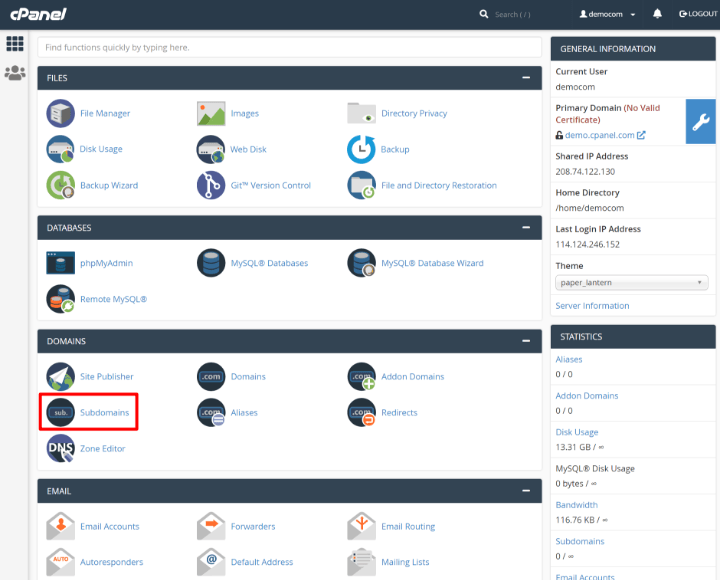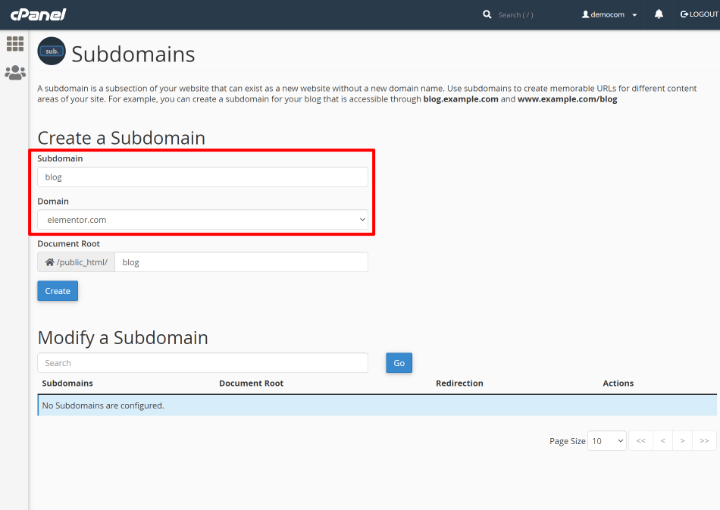How To Add A Subdomain In Wordpress
How to Set a Subdomain on Your WordPress Website
- Sergei Davidov
- onWordPress
- 10.01.21
- 10
Subdomains are a groovy mode to dissever websites — dividing them conspicuously and allocating them to specific target audiences for ameliorate and unique experiences. Discover what they are, why you should use them, and how to install a subdomain on WordPress.

There are many different purposes for different websites — some bargain with commerce, others with data, and others have to practice with marketing. What many people may not know is a unmarried website tin be additionally divided into smaller websites, for different purposes.
Y'all may want to create a staging website to test new updates, plugins, and themes; or, you may desire to create a carve up website to deal with eastward-commerce; or maybe you merely desire to create a articulate separation betwixt your mobile website and your desktop version, or maybe even a location-specific separation. To practise this — to carve up your website into smaller websites — y'all can apply subdomains.
A subdomain is an extension to your main domain name. It lets you lot create a separate "part" of your main domain — for example, blog.yoursite.com, and act as a dissever website.
In this postal service, we'll explicate why you may demand a subdomain to your WordPress site, and show you, footstep-past-step, how to utilize cPanel to gear up a subdomain and install WordPress.
Table of Contents
- When Should You Apply a Subdomain on WordPress?
- Subdomains vs Subfolders
- How To Install WordPress on a Subdomain
- i. Create a Subdomain
- 2. Install WordPress To That Subdomain
- Practice Subdomains Touch SEO?
- What Are the Pros and Cons of a Subdomain?
- Pros
- Cons
- Using Lots of Subdomains? Try WordPress Multisite
When Should You Use a Subdomain on WordPress?
Subdomains are separate websites, so you should employ a subdomain when you want to offer an feel that's entirely dissimilar from your main domain.
Let's expect at a few examples of how nosotros use subdomains here at Elementor to illustrate this. Our chief site – elementor.com – is targeted towards regular Elementor users or people who are interested in learning most Elementor, its features, and widgets. Then, we take several subdomains that offer different experiences. Hither are a few examples:
- my.elementor.com – this is the account dashboard for Elementor customers. It's where you lot tin can manage your license, subscription, websites, etc.
- developers.elementor.com– this subdomain is 100% focused on developers who want to piece of work with Elementor's code. It's not really relevant for regular Elementor users, which is why information technology makes sense to exist on its own subdomain.
- careers.elementor.com – this is for people who want to work at Elementor. Again, it's not really relevant for people who want to use Elementor on their own sites, which is why it gets its own subdomain.
Another examples of when to utilise a subdomain could exist:
- e-commerce shop blog – if your main site is an e-commerce store, y'all could create a subdomain to house your store's web log as that'south a singled-out experience from shopping for your products.
- Regional sites – if you have a multilingual site or otherwise localize your sites for different regions, you tin can utilise subdomains to segregate each region's site. For example, y'all could take de.yoursite.com (Germany), fr.yoursite.com (France), etc.
- Split up production lines – if you have completely different product lines, it can brand sense to split up them into subdomains. For instance, Disney has disneycruise.disney.go.com, disneyparks.disney.become.com, etc.
- Staging sites – you can create a WordPress staging site on a subdomain like staging.yoursite.com.
- Landing pages – if you want to create a landing page that's separate from your main site, you could place it on a subdomain.


Subdomains vs Subfolders
Some other common way to separate parts of your site is to use a subfolder, which comes subsequently your principal domain name instead of before:
- Subdomain: web log.yoursite.com
- Subfolder: yoursite.com/blog
For blogs, you'll run into some sites use the subdomain approach and others use the subfolder arroyo.
In full general, you lot should use the subfolder arroyo if your blog is closely tied to your primary domain proper name and the subdomain approach if your weblog is separate from your main domain (e.g. the eastward-commerce store example from to a higher place).
Here at Elementor, nosotros essentially use both approaches. Our main weblog is at elementor.com/blog (subfolder) but then we also have a split up programmer-focused weblog using both a subdomain and subfolder at developers.elementor.com/blog.
How To Install WordPress on a Subdomain
1. Create a Subdomain
Earlier you can install WordPress on a subdomain, you starting time need to create the bodily subdomain via your hosting dashboard.
To do this in cPanel, wait for the Subdomains tool in the Domains section:

On the adjacent screen, enter your desired subdomain in the Subdomain box and also select the parent domain via the Domain drib-downwards. There's no need to add together a dot afterward the subdomain – just enter the text you desire to utilise.
For example, to create blog.elementor.com, you would configure information technology like so:

2. Install WordPress To That Subdomain
Once you've created your subdomain, you lot can use your host's WordPress auto-installer to install WordPress on that subdomain.
When you install WordPress, you'll be able to select your subdomain only similar you can any other domain:

From at that place, everything behaves exactly as if you were installing WordPress on your parent domain.
Practice Subdomains Touch SEO?
Some other important consideration for using subdomains is search engine optimization (SEO). Because a subdomain is technically a "separate" site, some users worry that search engines won't pass the primary domain name's authorization to the subdomain.
For example, if yous take yoursite.com and blog.yoursite.com, some people worry that the blog won't do good from the chief domain proper name'southward authority.
According to Google'south John Mueller, Google can figure things out itself and there'due south no inherent SEO benefit to either subdomains or subfolders. If yous go back even further to Matt Cutts in 2012, he also said the aforementioned matter.
Some SEO experts all the same argue confronting this and worry that a subdomain won't inherit the full authorization from its parent domain, which could negatively touch on the rankings of content on the subdomain. Again, Google says that this isn't an result, but some people nevertheless adopt using subfolders for this reason.
Yet, one important SEO consideration for using subdomains is that you'll demand to add each subdomain to Google Search Console and each subdomain will take its ain reports. Depending on how yous're using your subdomains, you might view this as either a positive or a negative.
Additionally, John Mueller says that using subdomains can get in slightly harder for Google to figure out how to clamber your site. All the same, this isn't usually a problem subsequently the first week or so – it just takes Google a few days to brand the connection.


What Are the Pros and Cons of a Subdomain?
To finish things off, let's go over some of the pros and cons of using a subdomain.
Pros
- Separate experiences – subdomains make it easier to create completely different experiences for your users.
- Improved experiences – tying with the example above, creating separate experiences lets you optimize each experience for the user, instead of trying to fit everything into the aforementioned basic site design.
- Easier direction – if y'all have drastically different content, information technology might simplify your administrative processes to have each site be a separate WordPress install on a subdomain.
- Separate hosting – if you want, you can utilize completely dissever hosting services for each subdomain, which might be useful in some situations.
Cons
- Added complexity – each subdomain is a separate site, which adds complexity to your setup. For example, you might demand to manage two separate WordPress installs instead of one unified install. Similarly, you'll need to verify both domains in Google Search Console.
- SEO considerations – while Google says you lot tin can use either subdomains or subfolders, some SEO experts still recommend trying to apply subfolders whenever possible.
Using Lots of Subdomains? Endeavour WordPress Multisite
If y'all desire to create tens or hundreds of WordPress installs on subdomains, you might be better off creating a WordPress multisite network instead of creating separate WordPress installs on each subdomain. For example, let's say y'all run a local business with x dissimilar locations and you desire each location to accept its own subdomain.
Instead of creating ten carve up WordPress installs, you could utilize one WordPress multisite install and create a network site on each subdomain.
To larn more than, check out our guide to WordPress multisite.
Apply Subdomains the Right Way and Reap Their Benefits
WordPress subdomains can exist a useful tool if you want to create separate experiences for your visitors or otherwise create clearly separate parts of your site.
To install WordPress on a subdomain, you'll start need to add your subdomain via your hosting dashboard. Then, you can use your host'south machine-installer tool to install WordPress to that subdomain to launch your site.
Or, if y'all desire to use a lot of different subdomains, yous can consider setting up your own WordPress multisite network.
Do you still accept whatever questions near working with WordPress subdomains? Ask us in the comments!


Looking for fresh content?
Get manufactures and insights from our weekly newsletter.
Sergei Davidov is a content creator at Elementor. His favorite topics are gadgets, advances in science, new apps and software solutions. He enjoys spicy food, reading books and listening to elevator music.
How To Add A Subdomain In Wordpress,
Source: https://elementor.com/blog/setup-subdomain-wordpress/
Posted by: thompsonfalwye.blogspot.com


0 Response to "How To Add A Subdomain In Wordpress"
Post a Comment